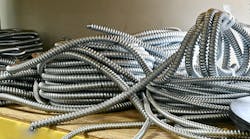Q. Can someone tell me if the National Electrical Code (NEC) limits running flexible metal conduit to any particular length? I ask this because I understand Greenfield for a light fixture shall not be longer than 6 ft. I would like to know if I can extend a 7-ft run of flexible metal conduit to a motor.
Answers based on the 1996 edition of the National Electrical Code.
A. The NEC does restrict the length of flexible metal conduit for lighting fixtures to 6 ft to limit the ground return path. Sec. 430-135(b) restricts the length of the motor leads between the motor and required junction box to a maximum of 6 ft, regardless of what type of conduit they are contained in — this pertains to the motor leads only. The length of flexible metal conduit for other uses isn’t restricted, while a grounding conductor is included with the circuit conductors. In response, the author may run any length of flexible conduit from the disconnect to the motor junction box, provided he also meets the requirements for support of the flexible conduit and location of the disconnecting means.
— E.C.G.
A. The limitation on the length of flexible conduit was removed from the Code several revisions ago. Before that, flex could only be a maximum 6 ft in length — in all cases. There are several references to 6 ft as a limitation on flexible conduit. However, here are the special cases noted.
- Section 350-10 (a) states several rules for 3/8 flexible metal conduit only — one being that this flexible conduit isn’t longer than 6 ft in certain instances. Other trade sizes aren’t affected by this rule. The Code rule of 6 ft for lighting tap conductors [Sec. 410-67(c)] still limits all lighting fixture tap conductors to 6 ft. So all flexible conduit used from the last outlet box to a lighting fixture must be 6 ft or less. This applies to all trade sizes used as lighting fixture tap conductors.
- You may use flexible metal conduit in any length as long as you follow the Code rules for support (Sec. 350-18) and grounding (Sec. 250-18).
- Section 250-18 limits flexible metal conduit to 6 ft only for grounding. In lengths over 6 ft, you must install a separate grounding conductor.
- Regarding the motor circuit in question, the equipment grounding conductor (EGC) must be terminated in accordance with Sec. 430-12(a) and Sec. 430-145.
—W.G.J.
A. The NEC allows a 7-ft extension of flexible metallic conduit (FMC) to a motor subject to the conditions in Art. 350. The primary restriction for lengths of FMC over 6 ft is it can’t be used for the ground fault return path. In general, if the overcurrent protective device is over 20A, you must install an equipment grounding conductor along with the circuit conductors. Flexible metallic conduit used in lengths over 6 ft must be supported within 12 in. of any conduit termination, at intervals not exceeding 4.5 ft.
—C.D.H.
A. The NEC permits longer runs of flexible metal conduit (FMC) with certain limitations. Per Sec. 250-9(b) (Grounding), a recognized equipment grounding conductor can be FMC where the conduit and fittings are listed for grounding. Both exceptions allowing FMC limit the length to 6 ft. If a grounding conductor is provided in the run, the armor is no longer acting as the grounding path, and the length isn’t limited under this section. For this, UL doesn’t test for the grounding ability of flexible metal conduit in lengths exceeding 6 ft, so there’s a possibility the Authority Having Jurisdiction (AHJ) wouldn’t approve an installation not providing a recognized grounding conductor. If the run were in excess of 6 ft, the added cost of a grounding conductor would be an inexpensive way to ensure NEC compliance.
—L.W.M.



